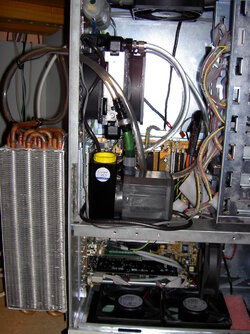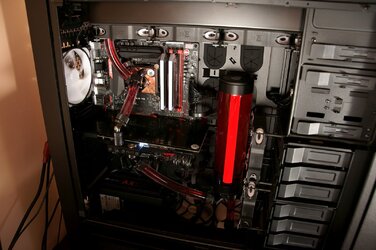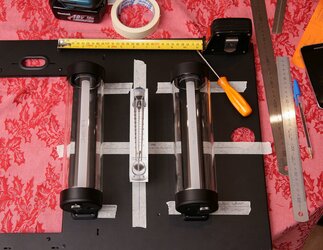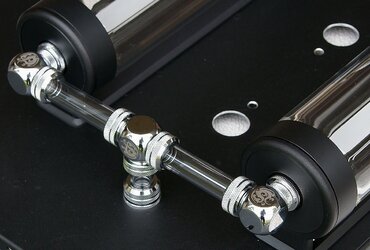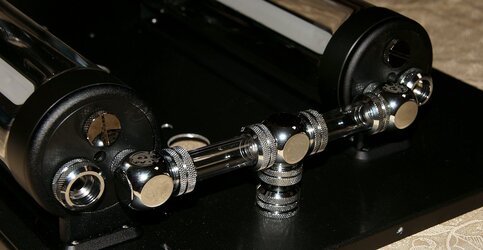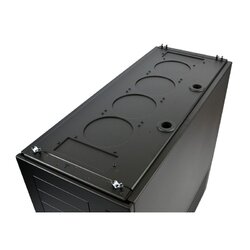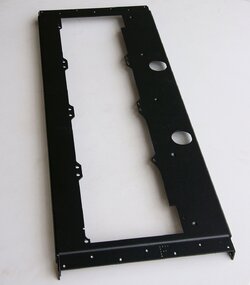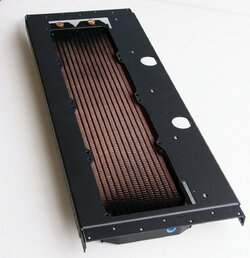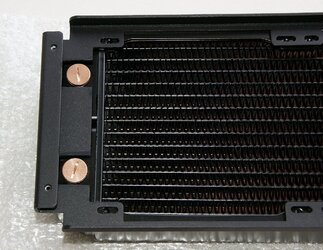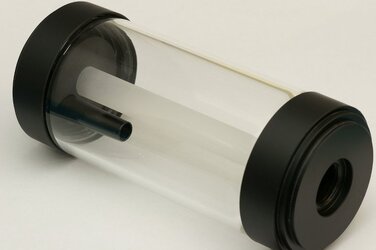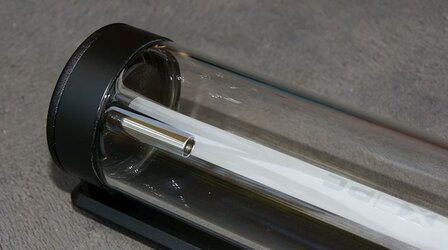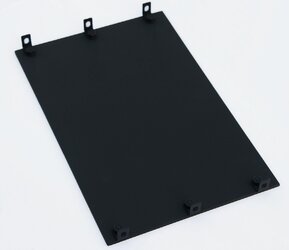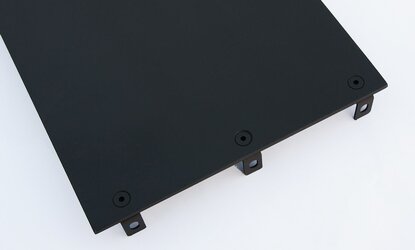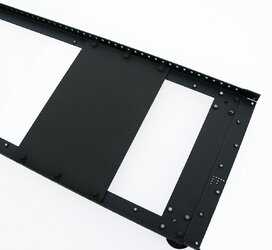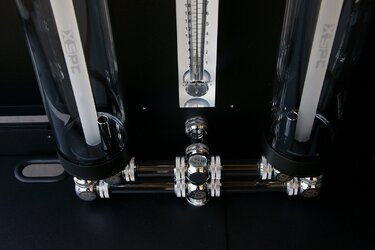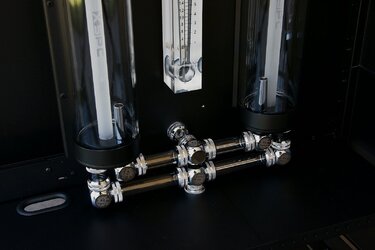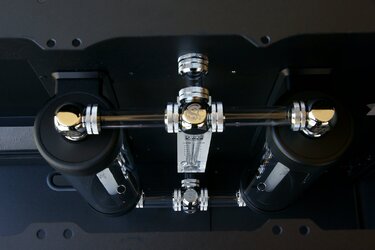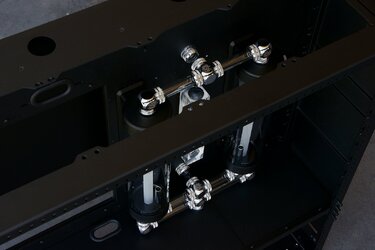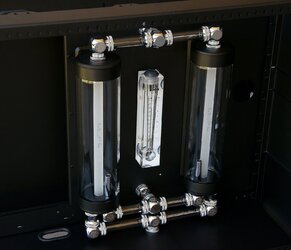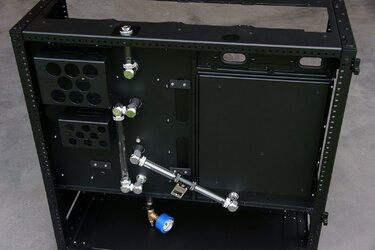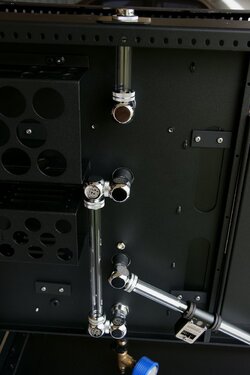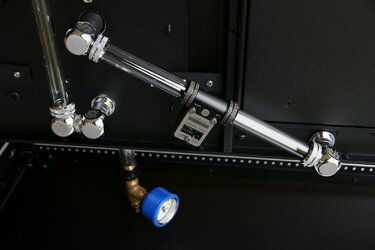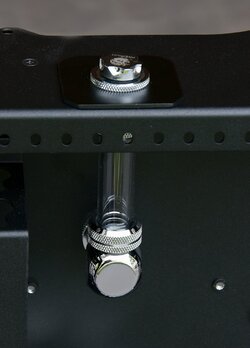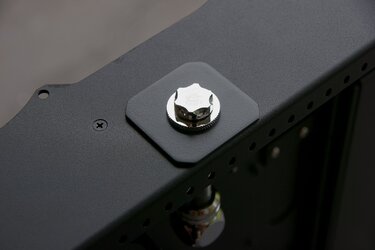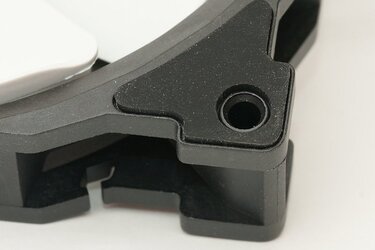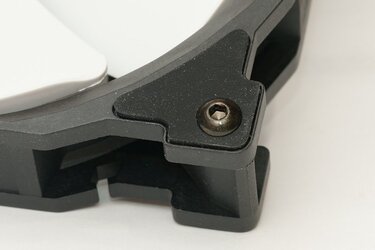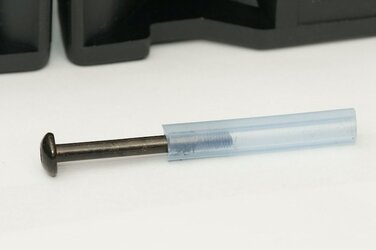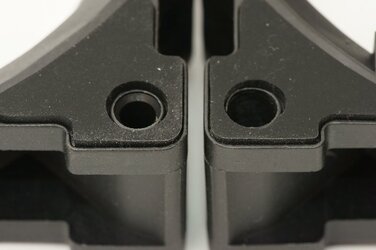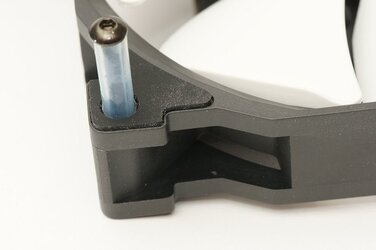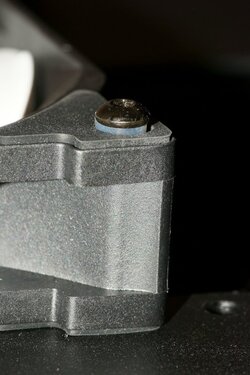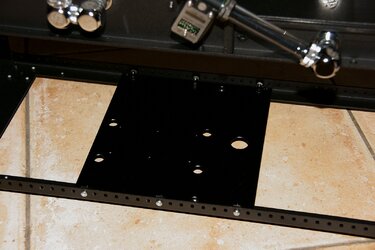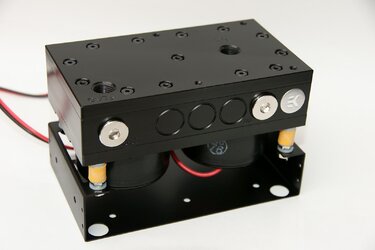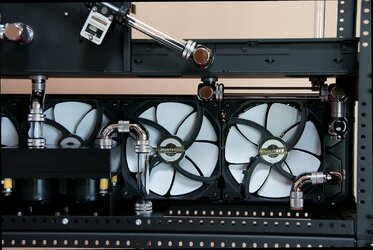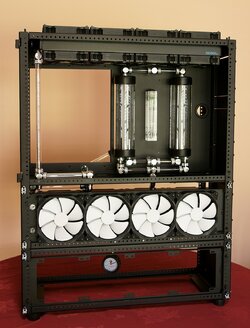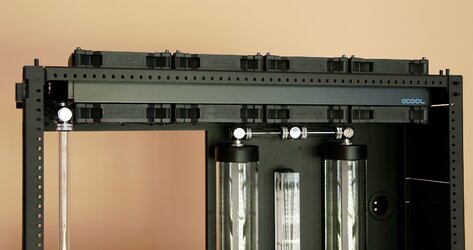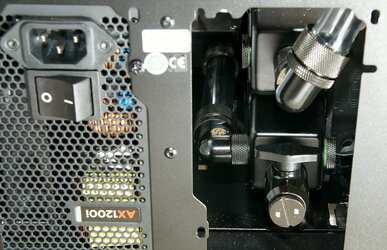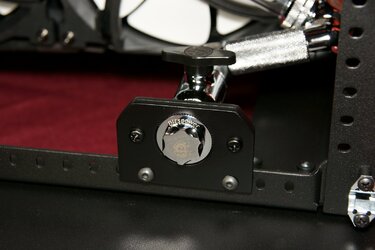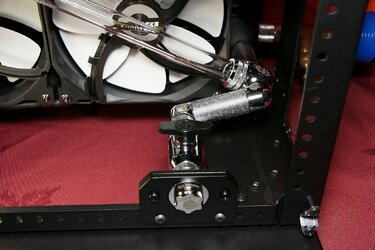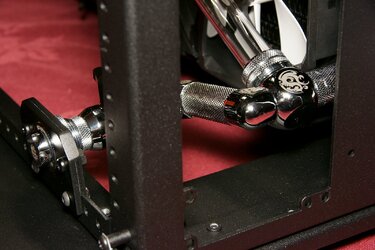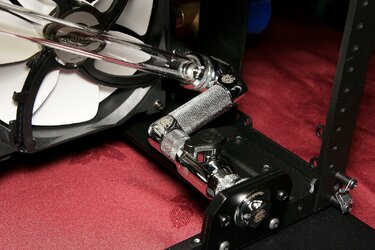Yeh I know most of you folks have seen it all before...
Here is another Caselabs SMA8 build but with a slight twist here and there.
It is my first acrylic build but certainly not my first WC endeavour. Hopefully it will look a tad more professional as compared to my first foray into watercooling from many years ago (circa early 90's - back in the Intel P2 & P3 era).
Here was that attempt - Worked pretty well for a number of years and it survived a number of upgrades during its reign...! Built in an old steel server case which was extremely heavy...ahh they were the days..
Back in June/July 2014 the WC bug bit again so I built a reasonably simple setup within a Corsair 900D. Single loop and was constructed from Primochill Advanced LRT with Bitspower fittings.
Here is a quick pic - It is my current rig and has been very reliable to date. 4790K running at 4.8Ghz [Cache @ 4.6Ghz] kitted out with an overvolted and overclocked EVGA 780Ti Classified - Main WC gear consists of a Swiftec MCP35X2, XSPC Photon and Alphacool rads all managed via an Aquaero 6XT.
So now I want to dabble with acrylic tubing so I decided on a Caselabs SMA8 build. I chose this case due to its similarities (form factor) with my Corsair 900D which I like.
As the SMA8 is quite roomy in some respects - I wanted to fill up the space to the right of the mobo with two reservoirs and whatever else. Since building my 900D, I also wanted to include a visual flowmeter - in particular an industrial rotameter styled flowmeter. Not for any technical reasons but more so as a bit of a talking point and the fact that I have not seen a build with one...!
I have not decided on any of the PC electronics hardware at this stage. I want to design my loop first and design it with some longevity/flexibility & overkill in mind so that just about any hardware config (within reason) can be added at any time once the loop is complete. I want to design the loop around the case more so than designing it around the actual electronic PC hardware as much as I can. I would prefer an end result whereby I can upgrade the PC electronics with minimal WC loop changes required. This should provide me with the best flexibility and return on investment (if you can call it that... ) over the life of the case and the expensive watercooling bits.
) over the life of the case and the expensive watercooling bits.
NOTE: I am not a fan of the look of bent tubing and I much prefer the more mechanical/muscular look of straight tubing combined with fittings when it comes to bends. While its easier to build in some respects (and more difficult in others) it is definitely way more expensive to go this way (many more fittings required). You can also run out of space in tight areas real quick as you need to allow for extra clearance for various fittings which may not be utilised if bending acrylic..
Here are some of the major components which I have already purchased and will be part of the build:
Case: Caselabs SMA8 (**maybe optioning it out with a pedestal - undecided on this as yet)
Reservoir: XSPC 270 Photons x2 - Connected in parallel
Radiators: Alphacool UT60 560 (Bottom) & Alphacool XT45 560 (Top - will require case mod). If I decide on the pedestal I will add another UT60 560 in the bottom.
Pumps and Top: D5 x2 matched to EK Dual Top for serial connection of pumps.
WC/Fan Controller: Aquaero 6XT - Coolant Flow to be monitored with MPS400 sensor.
Fittings: Bitspower Silver Shining utilised throughout build. 16mm Bitspower hardline/acrylic dual O-ring tubing compression style fittings for mating to acrylic tube.
Tubing: Bitspower 16mm OD acrylic.
Fans: TBA (Undecided at this stage but will be selecting 140mm variants).
Lets get started...!
As I want to keep the loop design simple & flexible I chose to opt for a single loop solution - However I really like a dual res setup for asthetics.
So I decided on connecting two reservoirs in parallel operation.
One advantage to this is that restriction is cut in half for the reservoirs, however the drawbacks are the extra fittings (cost) and a much more complex configuration for tubing routing.
Below is a pic from the other day when I just started to mark out my lines/positions for drilling etc.
Today I spent some time mounting the reservoirs and also playing with the acrylic tubing. The acrylic tubing itself is very cheap as compared to flexible tubing so no need to be worried if you end up making mistakes (cutting too short and the like).
There is a bit of a learning curve when it comes to cutting the tubing to the exact (correct) length. One needs to ensure that the tubing is cut with some clearance in mind to allow you to install & adjust the fittings for an exact parallel/square fit so that the tubing runs end up exactly square. You really need the acrylic tube to 'float' a little between its fittings rather than being hard up right against their ends while, at the same time being careful that the tubing is NOT cut too short which can prevent both o-rings from sealing correctly....!
Overall it did not take too long to get the hang of it. Tubing ends need to be chamferred and silicone grease applied to the o-rings for ease of fitment to the Bitspower fittings.
Top of reservoirs - Fill/Bleed ports are combined for parallel setup. Note pass-through connection through rear panel.
Bottom of reservoirs - Inlets joined together and passed through to the rear of the case via a pass-through fitting.
I have not finalised the outputs from the reservoirs as I am waiting on some fittings to come in. Should have them here on Monday. I will also need to assemble part of the case to measure out the exact location for the combined res output tube which needs to run through the mid plate for connection to the pumps.
More to come soon.....!!!
Here is another Caselabs SMA8 build but with a slight twist here and there.
It is my first acrylic build but certainly not my first WC endeavour. Hopefully it will look a tad more professional as compared to my first foray into watercooling from many years ago (circa early 90's - back in the Intel P2 & P3 era).
Here was that attempt - Worked pretty well for a number of years and it survived a number of upgrades during its reign...! Built in an old steel server case which was extremely heavy...ahh they were the days..
Back in June/July 2014 the WC bug bit again so I built a reasonably simple setup within a Corsair 900D. Single loop and was constructed from Primochill Advanced LRT with Bitspower fittings.
Here is a quick pic - It is my current rig and has been very reliable to date. 4790K running at 4.8Ghz [Cache @ 4.6Ghz] kitted out with an overvolted and overclocked EVGA 780Ti Classified - Main WC gear consists of a Swiftec MCP35X2, XSPC Photon and Alphacool rads all managed via an Aquaero 6XT.
So now I want to dabble with acrylic tubing so I decided on a Caselabs SMA8 build. I chose this case due to its similarities (form factor) with my Corsair 900D which I like.
As the SMA8 is quite roomy in some respects - I wanted to fill up the space to the right of the mobo with two reservoirs and whatever else. Since building my 900D, I also wanted to include a visual flowmeter - in particular an industrial rotameter styled flowmeter. Not for any technical reasons but more so as a bit of a talking point and the fact that I have not seen a build with one...!
I have not decided on any of the PC electronics hardware at this stage. I want to design my loop first and design it with some longevity/flexibility & overkill in mind so that just about any hardware config (within reason) can be added at any time once the loop is complete. I want to design the loop around the case more so than designing it around the actual electronic PC hardware as much as I can. I would prefer an end result whereby I can upgrade the PC electronics with minimal WC loop changes required. This should provide me with the best flexibility and return on investment (if you can call it that...
NOTE: I am not a fan of the look of bent tubing and I much prefer the more mechanical/muscular look of straight tubing combined with fittings when it comes to bends. While its easier to build in some respects (and more difficult in others) it is definitely way more expensive to go this way (many more fittings required). You can also run out of space in tight areas real quick as you need to allow for extra clearance for various fittings which may not be utilised if bending acrylic..
Here are some of the major components which I have already purchased and will be part of the build:
Case: Caselabs SMA8 (**maybe optioning it out with a pedestal - undecided on this as yet)
Reservoir: XSPC 270 Photons x2 - Connected in parallel
Radiators: Alphacool UT60 560 (Bottom) & Alphacool XT45 560 (Top - will require case mod). If I decide on the pedestal I will add another UT60 560 in the bottom.
Pumps and Top: D5 x2 matched to EK Dual Top for serial connection of pumps.
WC/Fan Controller: Aquaero 6XT - Coolant Flow to be monitored with MPS400 sensor.
Fittings: Bitspower Silver Shining utilised throughout build. 16mm Bitspower hardline/acrylic dual O-ring tubing compression style fittings for mating to acrylic tube.
Tubing: Bitspower 16mm OD acrylic.
Fans: TBA (Undecided at this stage but will be selecting 140mm variants).
Lets get started...!
As I want to keep the loop design simple & flexible I chose to opt for a single loop solution - However I really like a dual res setup for asthetics.
So I decided on connecting two reservoirs in parallel operation.
One advantage to this is that restriction is cut in half for the reservoirs, however the drawbacks are the extra fittings (cost) and a much more complex configuration for tubing routing.
Below is a pic from the other day when I just started to mark out my lines/positions for drilling etc.
Today I spent some time mounting the reservoirs and also playing with the acrylic tubing. The acrylic tubing itself is very cheap as compared to flexible tubing so no need to be worried if you end up making mistakes (cutting too short and the like).
There is a bit of a learning curve when it comes to cutting the tubing to the exact (correct) length. One needs to ensure that the tubing is cut with some clearance in mind to allow you to install & adjust the fittings for an exact parallel/square fit so that the tubing runs end up exactly square. You really need the acrylic tube to 'float' a little between its fittings rather than being hard up right against their ends while, at the same time being careful that the tubing is NOT cut too short which can prevent both o-rings from sealing correctly....!
Overall it did not take too long to get the hang of it. Tubing ends need to be chamferred and silicone grease applied to the o-rings for ease of fitment to the Bitspower fittings.
Top of reservoirs - Fill/Bleed ports are combined for parallel setup. Note pass-through connection through rear panel.
Bottom of reservoirs - Inlets joined together and passed through to the rear of the case via a pass-through fitting.
I have not finalised the outputs from the reservoirs as I am waiting on some fittings to come in. Should have them here on Monday. I will also need to assemble part of the case to measure out the exact location for the combined res output tube which needs to run through the mid plate for connection to the pumps.
More to come soon.....!!!
Last edited:
